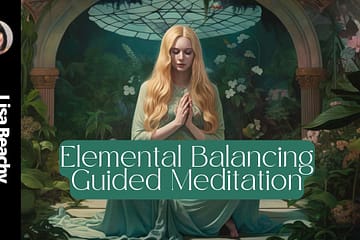What is Mindfulness Meditation?

What is Mindfulness Meditation? Your Guide to Inner Peace
Hello my dear friends! It’s so wonderful to connect with you here. 💕 I’m Lisa Beachy, a mindfulness meditation teacher and spiritual counselor. After going through a painful divorce and serious health issues several years ago, I felt stuck in a dark place emotionally and physically. Out of desperation, I started exploring mindfulness meditation as a way to find some relief and meaning. Boy am I glad I did! Through regular meditation and spiritual practices, I slowly began to heal, tap into my inner wisdom, and experience more joy and lightness day to day. Now I feel called to share these life-changing tools with others who are searching for greater peace and wellbeing.
In this guide, I want to answer the most common questions I receive about how to start a mindfulness meditation practice. Meditation can seem intimidating at first! But with an encouraging teacher to walk you through the basics, it becomes so fulfilling and even fun. My goal is to help you overcome any obstacles, so you can receive the incredible benefits that meditation has to offer. When we calm our busy minds and learn to be fully present, we access our natural state of spiritual connection, compassion, and bliss. Are you ready to create more stillness and connection in your life? Let’s begin this journey together!
What exactly is mindfulness meditation?
Mindfulness meditation is the practice of purposefully paying attention to the present moment without judgment. Rather than dwelling on the past or worrying about the future, mindfulness teaches us to calmly observe our thoughts and sensations as they come and go. The goal is not to empty the mind, but rather cultivate a non-reactive awareness of our inner and outer experiences. With regular practice, mindfulness meditation can radically transform how we relate to life’s inevitable ups and downs.
What are the benefits of mindfulness meditation?
The scientifically proven benefits of mindfulness meditation are extensive. With regular practice you can look forward to:
- Reduced stress, anxiety, and depression
- Enhanced focus and concentration
- More positive emotions like joy and gratitude
- Improved sleep quality
- Relief from chronic pain
- Increased self-awareness and emotional intelligence
- A greater sense of inner peace and balance
Mindfulness has also been shown to lead to structural brain changes that support mental health, cognition, and happiness.
What happens during a mindfulness meditation session?
A typical mindfulness meditation session goes something like this:
- Find a quiet place to sit comfortably. Set a timer for your desired length of practice.
- Bring your full attention to your breath as it enters and leaves your body.
- When your mind wanders from your breath, gently return your focus to the sensations of breathing.
- As thoughts, emotions, physical feelings, or outside sounds occur, simply notice them, and let them come and go without analysis or judgment.
- If you find yourself getting carried away in thought, gently return your attention to the breath.
- When the timer goes off, take a moment to observe how your mind and body feel before going about your day.
The simple practice of continually returning to sensory awareness of the breath trains our ability to stay calm, clear and centered amid whatever life brings.
How is mindfulness meditation different from other forms of meditation?
Mindfulness sets itself apart from visualization, mantra, and transcendental meditation in that it does not aim to achieve any particular state of consciousness. Rather, mindfulness accepts and observes whatever consciousness is present. For instance, if disturbing thoughts or strong emotions arise during mindfulness meditation, the intention is to neutrally notice them, not resist them or force them away. This trains equanimity and non-reactivity.
What is a typical length for a mindfulness meditation session?
While 20-30 minutes of daily meditation is ideal for beginners, starting with just 5-10 minutes per day can be immensely beneficial. Consistency is key. As your practice deepens, you may naturally find yourself drawn to longer sits. Even one minute of mindful breathing can reset your nervous system if you bring full awareness to the present moment. Start where you are, and gradually increase as desired.
What is the best way for a beginner to start practicing mindfulness meditation?
To make starting a meditation practice as easy as possible, follow these three steps:
- Download a meditation app like Headspace, Calm, or Insight Timer. These will guide your sessions.
- Pick a consistent time and trigger. Practice first thing in the morning, during a lunch break, or while drinking your afternoon tea.
- Start small. Commit to just 5 or 10 minutes per day. Consider pairing your meditation with a soothing activity like sipping herbal tea, diffusing essential oils, or sitting near flowing water or trees in nature.
Making mindfulness meditation a part of your daily routine primes your mind to respond to stress with equanimity instead of reactivity. Be patient with yourself as you build this new habit.
What should I do when my mind won’t stop wandering during meditation?
Our minds are conditioned to be busy, so it’s natural for thoughts to wander 100 times in a meditation session. Instead of getting frustrated, remember that noticing when your mind has wandered, and repeatedly guiding it back to your anchor of focus (often the breath), is the actual mindfulness meditation practice. Just keep gently returning to the sensate present. No need to judge yourself. With time and practice, you’ll strengthen your capacity for present moment awareness.
What are some mindfulness meditation tips for beginners?
Mindfulness meditation is simple, but not necessarily easy. Try these tips to overcome common beginner hurdles:
- Label thoughts as “thinking” and let them go without judging yourself
- Set your alarm slightly early to avoid time anxiety
- Find a posture that is stable and alert, yet relaxed
- Focus on each full inhale and exhale rather than taking shallow rapid breaths
- Open your eyes if falling asleep, or close them if distracted
- Observe feelings without reacting or clinging to them
- Start small – don’t set the expectation of blissful meditation every session
Remember, meditation practice takes patience. Don’t give up. The benefits are so worth the initial learning curve.
How long before I experience the benefits of mindfulness meditation?
While benefits can come quickly, most research shows it takes about 8 weeks of consistent mindfulness meditation to experience meaningful changes. That said, many people report uplifted mood, reduced anxiety, and increased focus right from the beginning. Trust the process. Your effort will pay off down the road.
Conclusion
I hope these frequently asked questions have shed light on the transformative practice of mindfulness meditation. With an attitude of open curiosity, patience and non-striving, it is possible to cultivate greater inner peace amid the stresses of daily life. Consider trying mindfulness meditation for yourself, starting today. Your own lived experience will reveal more than any words can describe. Wishing you clarity, compassion, and bliss on your journey within.
Summary
| Topic | Summary |
|---|---|
| What is mindfulness meditation? | The practice of purposefully paying attention to the present moment without judgment. |
| Benefits | Reduced stress and improved emotional regulation, focus, sleep quality, physical pain, self-awareness. |
| What happens during meditation | 1. Sit comfortably, 2. Focus on breath, 3. Notice thoughts/feelings without judgment, 4. Return focus to breath. |
| How it’s different | Accepts whatever arises vs forcing a state of consciousness. |
| Session length | 5-30 mins for beginners. Consistency is key. |
| How to start | Use an app, pick a consistent time, start small. |
| Dealing with wandering mind | Gently return focus to anchor. Don’t judge yourself. |
| Tips for beginners | Label thoughts, relax posture, focus on full breath, start small. |
| Timeline for benefits | Research shows 8 weeks of consistent practice. |
Frequently Asked Questions
What is mindfulness meditation?
Mindfulness meditation is the practice of purposefully paying attention to the present moment without judgment. Rather than dwelling on the past or worrying about the future, mindfulness teaches us to calmly observe our thoughts and sensations as they come and go.
What are the benefits of mindfulness meditation?
The benefits are reduced stress, anxiety, and depression, as well as enhanced focus, positive emotions, sleep quality, pain relief, self-awareness, inner peace, and balance. Mindfulness meditation can lead to structural brain changes that support mental and emotional health.
How long should I meditate each day?
For beginners, aim for 5-10 minutes per day. 20-30 minutes daily is ideal once you have established a practice. Even just 1-2 minutes can be helpful. The key is consistency.
How do I meditate?
Find a quiet place, sit comfortably, and set a timer. Bring your full attention to your breath, and when your mind wanders, gently return focus to your breath. Notice thoughts and feelings without judgment before letting them go.
What if I struggle with a wandering mind?
It’s completely normal for your mind to wander often during meditation. Just gently guide your attention back to your anchor. Don’t judge yourself. Repeatedly returning to your anchor is the practice.
How long before I see changes?
Research shows it takes about 8 weeks of consistent practice to experience meaningful benefits. However, some people report positive changes right away. Have patience and trust the process.
How can I make meditation a daily habit?
Pick a consistent time and trigger, like morning or before dinner. Use a meditation app for guidance. Start with just 5 minutes a day. Pair it with relaxing activities like sipping tea or sitting outside.
or I have my YouTube Readings Channel : Intuitive Aries, Lisa Beachy
Learn more about Angels – Click Here



